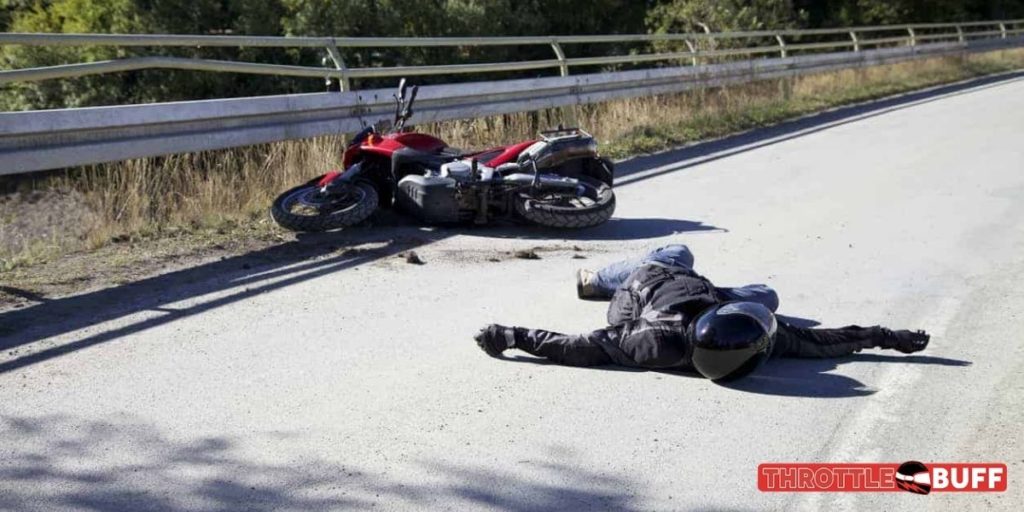Road rash appears to be a non-issue at first glance. Isn’t it true that rashes heal? Isn’t it a non-issue?
Not so fast, my friend. To be sure, a road rash injury could be nothing more than a scrape on a child’s arm or leg caused by falling off a bike or skateboard. It hurts, and it needs to be cleaned, but it will heal if you provide some basic first aid to the wound. On the other hand, other road rash injuries can be much more severe than the kind of childhood booboo that the name suggests. The road rash resulting from a motorcycle collision is a major trauma that carries serious health concerns, high medical costs, and the possibility of lifelong scarring, among other consequences.
These more severe examples of road rash are discussed in detail in this blog post, as well as how to treat them. You will never have to go through the excruciating pain and lengthy recovery period associated with one of these injuries with any luck. However, in the event that you suffer a major road rash injury, we hope that this article may be of assistance.
What Is the Cause of Road Rash?
It is harmful to the skin and soft tissue caused by friction with a road surface that is known as “road rash” (usually, but not always, pavement). It is one of the most prevalent types of injuries sustained in motorcycle accidents, and it can manifest itself in several different ways:
- As with sandpaper on wood, abrasion is the process by which the road surface removes layers of skin.
- When the road surface shreds the skin or separates a skin layer from the one beneath it, this is referred to as avulsion.
- Laceration, in which the road surface’s characteristics slice the skin; and abrasion, in which the road surface’s features cut the skin.
- A thermal burn is a type of skin burn caused by friction with the road surface, which generates heat and causes the skin to burn.
Almost any of these injuries can result in considerable trauma and health hazards on its own. However, when they occur together as part of a road rash, they can be just as dangerous as a serious burn or a gunshot wound in terms of potential death. In fact, just like they do with burn injuries, doctors categorize road rash injuries according to their severity.
Additionally, these basic injuries may result in secondary health issues (much like a severe burn can). They are as follows:
- Infection: The breadth and depth of the injuries caused by road rash, which are sometimes coated with soil, can allow hazardous germs to enter the wound, resulting in a life-threatening infection.
- Tissue and nerve damage and other complications: Road rash, particularly deep and severe occurrences, can cause nerve cell and muscle tissue damage.
- Disfiguring scars and traumatic tattoos: A large abrasion will almost always result in a scar. A traumatic tattoo is a persistent coloring of the healed skin caused by surgeons’ inability to remove dirt and other foreign objects from the incision. If this occurs, the lesion will be permanently discolored.
A severe case of road rash may result in a variety of consequences, which are listed below. Anyone who has suffered from anything more serious than a moderate case of road rash must seek medical assistance immediately. It is possible that waiting too long to seek medical assistance (or skipping it completely) will put you at risk of contracting a life-threatening infection that will deteriorate exceptionally quickly.
What to Do If You Have Road Rash
The severity of road rash injuries varies. You can use the kind of first aid measures outlined below to address the most severe conditions. More severe injuries, on the other hand, necessitate immediate medical attention and may require hospitalization. If you have any doubts about your ability to cure a case of road rash on your own, it is best to be safe and visit the doctor as soon as possible.
How to Treat Road Rash at Home
Taking Care of Road Rash Burns Simply treating simple motorcycle accident road rash cases at home (we’re talking about cuts and scrapes similar to those sustained by a youngster after falling from his bike) is a viable alternative to going to the emergency room. Listed below are the measures that you should follow to treat minor road rash at home.
- It would be best if you washed your hands: Infected road rash wounds are a serious health hazard. Make a point of thoroughly cleaning your hands before treating an open wound to avoid introducing potentially hazardous bacteria into the wound.
- Gently wipe the wound with a damp cloth: In order to accomplish this, the primary strategy should be to flush the wound with water. If you choose to use gauze or a cotton swab, be as mild as possible. Avoid scrubbing a road rash wound since this could result in debris and other potentially hazardous substances being pushed further into the wounded tissue.
- Remove all foreign stuff from the area: If flushing and (very) carefully washing the wound does not entirely remove the dirt and debris, then you should use a pair of tweezers to extricate the debris. Be kind to yourself once more.
- It would be best if you used antibiotic ointment: The ointment is used for two different purposes. It aids in the prevention of infection and the formation of a layer that prevents a bandage from adhering to the lesion.
- Bandage: If possible, use a basic bandage to protect the wound. In most cases, though, medical tape and sterile gauze will be required.
- Reapply the ointment/bandage as needed: Change the bandage on your wound on a regular basis to help avoid infection. Unlike certain other types of cuts and scrapes, road rash injuries do not heal as soon as they should. Leaving a soiled bandage on them could be hazardous to their health.
- Keep a watch out for any signs of illness: Watch for signs of an infection coming in, such as swelling that continues to grow, redness radiating from the site, foul-smelling puss, increasing discomfort, and nausea. Any of these symptoms could indicate a potentially life-threatening infection that necessitates emergency medical attention.
If any of the actions outlined above appear to be beyond your comprehension, consult your doctor. Do not expose yourself to the risk of illness or irreversible scars.
Treatment for Road Rash in a Medical Setting
A doctor will evaluate the severity of a case of road rash in the same way that it explained previously. If the situation is serious, a doctor’s office will follow the same basic processes outlined above in order to treat the patient in question. Medical literature recommends a course of treatment that is similar to what a doctor would administer in the case of a severe thermal burn in more difficult situations. Debriding the wound, conducting a skin graft, and administering IV fluids, and performing shock resuscitation are all examples of procedures that you may perform.
In addition, doctors will employ treatments that are similar to those used in thermal burn therapy to manage secondary health concerns that may arise. It may be required to administer intensive rounds of antibiotics in order to treat any infection that has developed. As a precaution against additional infection, the doctor may place the patient in a ward that has been carefully built.
In addition, because a severe case of road rash can cause damage to muscle tissue and nerve endings, doctors may recommend a course of physical or occupational therapy to aid in the recovery of a road rash victim. Finally, this care can cost thousands of dollars in the long run.
The Other Real-Life Consequences of Road Rash and How to Treat Them
However, medical therapy for severe road rash caused by a motorcycle accident is only part of the image. Medical fees, missed wages, property damage, and other financial consequences of a severe case of motorcycle accident road rash can follow victims long after the wound has healed. The physical and mental trauma of having experienced a traumatic, terrifying, and life-altering accident and injury can also be devastating.
These consequences necessitate the same level of “therapy” as the medical disorders caused by road rash. But how do you do it?
The rider is not always responsible for his own wounds in motorbike accidents. If this is the case, the rider may be able to seek compensation from the party or parties who caused him harm through their acts. Consider the following scenario:
- Negligence on the part of the driver or deliberate aggressiveness on the part of the driver Motorcyclists have the same rights as everyone else to use Washington State roads. Other motorists, unfortunately, do not always treat bikers with the respect they deserve. Motorists routinely cut off motorcycle riders, fail to notice riders in their blind zones, turn left across a motorcyclist’s path, and open car and truck doors in front of them. Some drivers even engage in hostile driving behaviors (such as road rage) that are directed against motorcycle riders. When a motorcycle accident occurs as a consequence of a motorist’s negligence or reckless behavior, the motorist (or, in some situations, the motorist’s employer) may be liable to the rider who suffered severe road rash as a result of the collision.
- Road conditions are hazardous: Every type of road user should feel comfortable on Washington’s roads. Unfortunately, road construction personnel and road maintenance organizations sometimes take shortcuts or leave roads in dangerous conditions for motorcycle riders. You should warn motorcyclists about unrepaired potholes, grooved pavement, road debris, and other situations that could cause them to lose control at the very least. When someone fails to issue these warnings and correct the dangerous condition, they may be held legally responsible for the motorcyclist’s road rash injuries.
- Defective equipment: Motorcycle and aftermarket motorcycle parts manufacturers have several responsibilities to the general public in terms of product quality and safety. If a defective product causes a motorbike accident and the rider suffers from severe road rash, the producer could be held liable.
How Can You “Avoid” The Road Rash
We’d be remiss if we didn’t include information on how to avoid a severe case of road rash in the first place when writing about road rash treatments. For motorcyclists and the general public, the problem of road rash is nothing new. Here are some tried-and-true strategies for avoiding the worst cases of road rash:
Wearing protective gear:
Motorcyclists can wear a variety of protective clothing to lower their risk of road rash. The motorcycle gear industry is continually introducing new types of abrasion-resistant pants and jackets. When used in conjunction with a helmet. This gear can help you avoid getting road rash or, at the very least, reduce the severity of a road rash injury.
Trip planning:
Knowing the roads you’ll be riding on can assist you in avoiding getting into a motorbike accident.
Be cautious and ride responsibly:
As a motorcycle rider, you, like any other motorist, have a vital role to play in keeping yourself safe. Observe the traffic laws. Don’t go too fast. Keep an eye out for warnings and traffic signals. Never, ever ride your bike after drinking or taking medicines or prescriptions that make you drowsy. Also, avoid riding if you know you’ll be exposed to hazardous weather conditions that could result in injury.
Conclusion
We hope that our information will help you to be saved from road rashes that usually happen with motorcycles. If you have any other doubts, you can ask us in the comment section. Drive safely!



